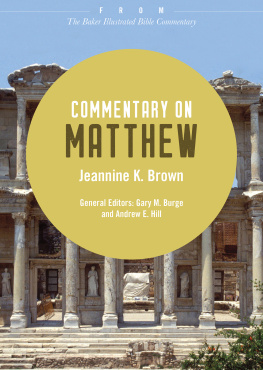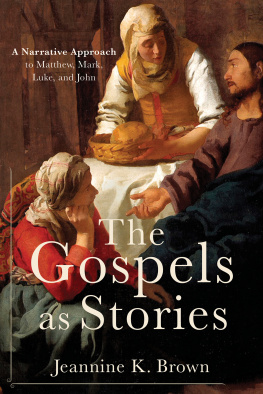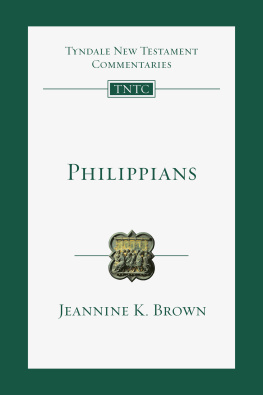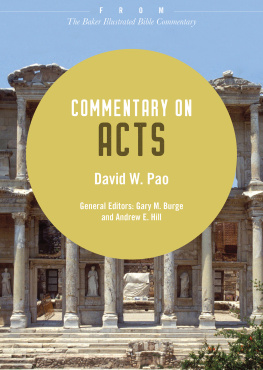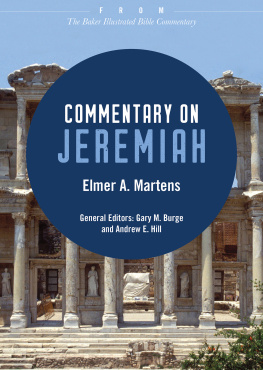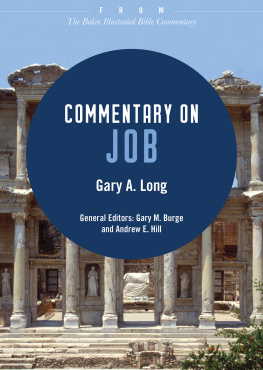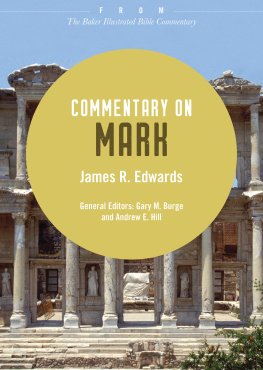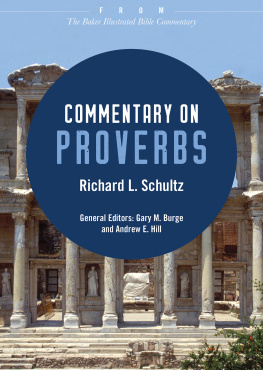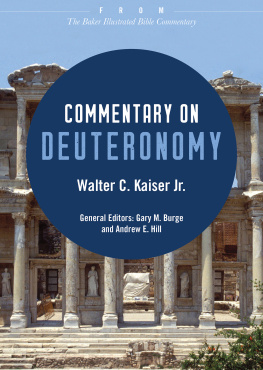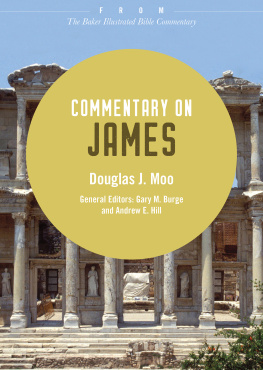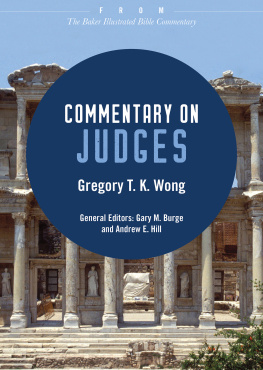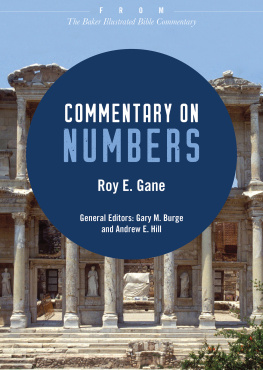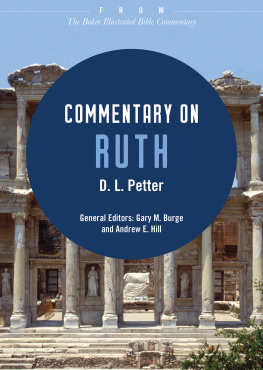Jeannine K. Brown - Commentary on Matthew: From The Baker Illustrated Bible Commentary
Here you can read online Jeannine K. Brown - Commentary on Matthew: From The Baker Illustrated Bible Commentary full text of the book (entire story) in english for free. Download pdf and epub, get meaning, cover and reviews about this ebook. year: 2019, publisher: Baker Publishing Group, genre: Religion. Description of the work, (preface) as well as reviews are available. Best literature library LitArk.com created for fans of good reading and offers a wide selection of genres:
Romance novel
Science fiction
Adventure
Detective
Science
History
Home and family
Prose
Art
Politics
Computer
Non-fiction
Religion
Business
Children
Humor
Choose a favorite category and find really read worthwhile books. Enjoy immersion in the world of imagination, feel the emotions of the characters or learn something new for yourself, make an fascinating discovery.
- Book:Commentary on Matthew: From The Baker Illustrated Bible Commentary
- Author:
- Publisher:Baker Publishing Group
- Genre:
- Year:2019
- Rating:5 / 5
- Favourites:Add to favourites
- Your mark:
- 100
- 1
- 2
- 3
- 4
- 5
Commentary on Matthew: From The Baker Illustrated Bible Commentary: summary, description and annotation
We offer to read an annotation, description, summary or preface (depends on what the author of the book "Commentary on Matthew: From The Baker Illustrated Bible Commentary" wrote himself). If you haven't found the necessary information about the book — write in the comments, we will try to find it.
Commentary on Matthew: From The Baker Illustrated Bible Commentary — read online for free the complete book (whole text) full work
Below is the text of the book, divided by pages. System saving the place of the last page read, allows you to conveniently read the book "Commentary on Matthew: From The Baker Illustrated Bible Commentary" online for free, without having to search again every time where you left off. Put a bookmark, and you can go to the page where you finished reading at any time.
Font size:
Interval:
Bookmark:
2012 by Baker Publishing Group
Published by Baker Books
a division of Baker Publishing Group
P.O. Box 6287, Grand Rapids, MI 49516-6287
www.bakerbooks.com
Ebook short created 2019
Previously published in The Baker Illustrated Bible Commentary edited by Gary M. Burge and Andrew E. Hill in 2012
All rights reserved. No part of this publication may be reproduced, stored in a retrieval system, or transmitted in any form or by any meansfor example, electronic, photocopy, recordingwithout the prior written permission of the publisher. The only exception is brief quotations in printed reviews.
Library of Congress Cataloging-in-Publication Data is on file at the Library of Congress, Washington, DC.
ISBN 978-1-4934-2463-4
Unless otherwise indicated, Scripture quotations are from the Holy Bible, New International Version. NIV. Copyright 1973, 1978, 1984, 2011 by Biblica, Inc. Used by permission of Zondervan. All rights reserved worldwide. www.zondervan.com. The NIV and New International Version are trademarks registered in the United States Patent and Trademark Office by Biblica, Inc.
Scripture quotations labeled ESV from The Holy Bible, English Standard Version (ESV), copyright 2001 by Crossway, a publishing ministry of Good News Publishers. Used by permission. All rights reserved. ESV Text Edition: 2007
Scripture quotations labeled NASB are from the New American Standard Bible, copyright 1960, 1962, 1963, 1968, 1971, 1972, 1973, 1975, 1977, 1995 by The Lockman Foundation. Used by permission. www.lockman.org
Scripture quotations labeled NIV 1984 are from the HOLY BIBLE, NEW INTERNATIONAL VERSION. NIV. Copyright 1973, 1978, 1984 by International Bible Society. Used by permission of Zondervan. All rights reserved.
Scripture quotations labeled NJPS are from the New Jewish Publication Society Version 1985 by The Jewish Publication Society. All rights reserved.
Scripture quotations labeled NKJV are from the New King James Version. Copyright 1982 by Thomas Nelson, Inc. Used by permission. All rights reserved.
Scripture quotations labeled NLT are from the Holy Bible , New Living Translation, copyright 1996, 2004, 2007 by Tyndale House. Used by permission of Tyndale House Publishers, Inc., Carol Stream, Illinois 60188. All rights reserved.
Scripture quotations labeled NRSV are from the New Revised Standard Version of the Bible, copyright 1989, by the Division of Christian Education of the National Council of the Churches of Christ in the United States of America. Used by permission. All rights reserved.
Scripture quotations labeled RSV are from the Revised Standard Version of the Bible, copyright 1952 [2nd edition, 1971] by the Division of Christian Education of the National Council of the Churches of Christ in the United States of America. Used by permission. All rights reserved.
Unless otherwise indicated, photos, illustrations, and maps are copyright Baker Photo Archive.
| ANET | Ancient Near Eastern Texts Relating to the Old Testament . Edited by J. B. Pritchard. 3rd ed. Princeton, 1969 |
| BDAG | Bauer, W., F. W. Danker, W. F. Arndt, and F. W. Gingrich. Greek-English Lexicon of the New Testament and Other Early Christian Literature. 3rd ed. Chicago, 1999 |
| ca. | circa (about, approximately) |
| cf. | compare |
| chap(s). | chapter(s) |
| COS | The Context of Scripture . Edited by W. W. Hallo. 3 vols. Leiden, 1997 |
| e.g. | for example |
| ESV | English Standard Version |
| HALOT | Koehler, L., W. Baumgartner, and J. J. Stamm. The Hebrew and Aramaic Lexicon of the Old Testament. Translated and edited under the supervision of M. E. J. Richardson. 5 vols. Leiden, 19942000 |
| HCSB | Holman Christian Standard Bible |
| i.e. | that is |
| KJV | King James Version |
| NASB | New American Standard Bible |
| NEB | New English Bible |
| NET | New English Translation |
| NIV | New International Version (2011 edition) |
| NIV 1984 | New International Version (1984 edition) |
| NJB | New Jerusalem Bible |
| NJPS | The Tanakh: The Holy Scriptures: The New JPS Translation according to the Traditional Hebrew Text |
| NKJV | New King James Version |
| NLT | New Living Translation |
| NRSV | New Revised Standard Version |
| RSV | Revised Standard Version |
| TDOT | Theological Dictionary of the Old Testament . Edited by G. J. Botterweck and H. Ringgren. Translated by J. T. Willis, G. W. Bromiley, and D. E. Green. 8 vols. Grand Rapids, 1974 |
| TNIV | Todays New International Version |
Jeannine K. Brown
Introduction
Purpose
The author of the Gospel of Matthew, writing to believers in Jesus in the latter part of the first century, portrays Jesus as Gods chosen Messiah, who paradoxically ushers in the reign of God through his self-giving ministry and death. Matthew communicates that Jesuss messianic claims and mission are vindicated at his resurrection, when God grants him all authority. Matthew seeks to persuade his readers to respond in trust, loyalty, and obedience to Jesus Messiah and his teachings and to empower them to invite others to follow and obey Jesus through the promise of Jesuss presence with them.
A Narrative Reading
This commentary offers a narrative reading of Matthew, emphasizing its story features, internal coherence, and thematic development. Narrative criticism as a method for studying the Gospels analyzes a narrative at two levelsstory and discourse. Analysis of the story level focuses on setting, character, and plot development. Discourse-level assessment focuses on the ways the implied author (implied within the narrative) tells the story to communicate with the implied audience. An author communicates on the discourse level through sequencing (see Sources below), structural devices (see Structure below), thematic development, and authorial comments. (For a description of narrative analysis, including implied author and audience concepts, see Brown 2007, 15763, also 4042.) For example, Matthew narrates nine miracle stories in 8:19:34 in order to stress themes of Jesuss authority and the importance of faith. Thus, while attending to story and discourse levels, a narrative reading also seeks to understand the book of Matthew in light of its historical setting.

Author, Date, and Audience
Although the Gospel itself is anonymous, the title (added in the second century) specifies Matthew as the author. Church tradition also attributes it to Matthew the apostle (Eusebius, Ecclesiastical History 3.24.16, citing testimony from Papias, a second-century bishop). Modern scholarship has questioned these traditions, but certain scholars continue to support Matthew as the author of the first Gospel (see discussion in Keener, 3841).
One difficulty for determining authorship is the nature of narratives, which point away from the author and toward the story being told. Matthews author intends the audience to focus its attention on Jesus and the events and time frame of his life rather than on the author and the authors world. Yet reconstructing something about the author, audience, and date from the Gospel is possible by studying indirect references within the story (e.g., does 22:7 indicate Matthew writes after the destruction of Jerusalem?) and attending to direct authorial commentary where it occurs (e.g., 24:15; 28:15). Such reconstruction of the implied author, date, and audience (implied within the narrative) may be sketchy, since internal evidence can support contrasting reconstructions (as in the dating of Matthew).
Font size:
Interval:
Bookmark:
Similar books «Commentary on Matthew: From The Baker Illustrated Bible Commentary»
Look at similar books to Commentary on Matthew: From The Baker Illustrated Bible Commentary. We have selected literature similar in name and meaning in the hope of providing readers with more options to find new, interesting, not yet read works.
Discussion, reviews of the book Commentary on Matthew: From The Baker Illustrated Bible Commentary and just readers' own opinions. Leave your comments, write what you think about the work, its meaning or the main characters. Specify what exactly you liked and what you didn't like, and why you think so.

